Audio systems for distributed music, or distributed audio, arise from multiple needs whose common denominator is to broadcast voice messages, or music, in environments other than the one where the speaker or sound source is located. Ideal for broadcasting speech in places such as train stations, airports, sports centers, offices, parking lots, and art galleries, they are equally suitable for playing background music, with possible inclusion of alerts or hands-free calls, in places such as department stores, supermarkets, theme parks, beach or spa establishments, shopping malls, beauty salons, etc. These are therefore specific applications quite different from those of a PA system for show biz, theaters and auditoriums.
We will deal specifically with 70/100 V systems-amplifiers and loudspeakers-highlighting the differences from traditional systems, also known as “low impedance” systems. Learn about Audio Effetti’s proposals for room sounding that require distributed audio systems.
When speakers are never enough!
In installations for diffuse music, one thing is certain: we need many loudspeakers (in-wall, in-wall, or in-ceiling) or speakers, since the rooms to be sounded are either vast or consist of many well-defined areas. Think, in the first case, of an airport terminal and in the second case of a museum.
We know very well, however, that we cannot connect too large a number of speakers to a conventional type of amplifier because of load problems. Two identical 8-ohm speakers in parallel on one output are in fact seen by the amplifier as a load (impedance) of 4 ohms, and four speakers as a load of 2 ohms, and so on. As we continue to add speakers, the impedance goes lower and lower, reaching values that can approach short circuit, with the powers that correspondingly continue to increase. Under these conditions-it can be several thousand watts-the amplifier cannot continue and deliver power and reaches a point where protections kick in. That being said, if you anticipate having to connect many speakers/speakers to your amplifier, you are left with only three options:
- Use high impedance speakers (e.g. 16 or 32 ohms)
- Use multichannel amplifiers (typically up to 8 channels)
- Drive live speakers using a 100 V amplifier..
…And it is exactly the latter that we will focus on.
How do 100 V systems work?
Constant-voltage systems, typically 100 but also 70 V (the standard most widely used in the U.S.), are designed to simplify as much as possible the problem of power distribution to the loudspeakers and load variation due to insertion (or removal) on the line of the loudspeakers themselves. The term “constant voltage” refers only to the fact that, in the prepared circuits, the voltage produced by the amplifier remains constant even for considerable variations in load impedance.
100-V amplifiers differ completely from conventional 2-channel, or multichannel amplifiers, first of all because they are monophonic. Stereophony does not matter in a context where we will never be in the middle of two Left and Right speakers as in the living room at home or in a recording studio. If you connect a stereo source, as most are excluding the microphone, the amplifier will sum the two channels generating a mono L + R signal and will broadcast to all connected speakers/speakers the same signal, amplified.
The second, but more important difference, concerns the output: in 100 V amplifiers there is a common terminal and a high-voltage terminal, 100 V precisely. To these terminals we connect all the speakers in parallel that are part of our loudspeaker system: from the amplifier to the first speaker, from the first to the second, from the second to the third, and so on, without, moreover, worrying too much about the cross section of the cable and its length, which can easily reach 100 m.
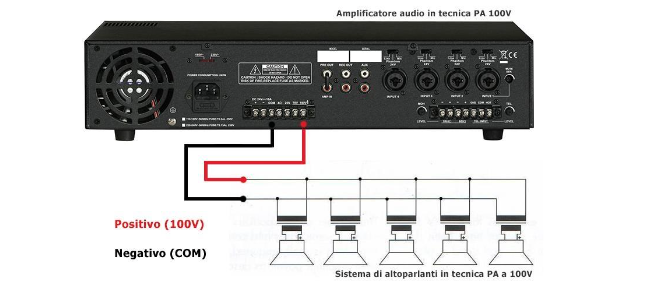
At this point a question arises: how many speakers can I connect? The answer is very simple since the determination of the applied power can be done with a very simple calculation, which makes life not a little easier for installers! Basically, just add up the powers of the individual speakers. Put another way, if we are in the ideal case and we have a 100 W @ 100 V amplifier, to it we will be able to connect:
- 5 20 W speakers (5 x 20 = 100 W)
- 10 W speakers (10 x 10 = 100 W)
- 20 5 W speakers (20 x 5 = 100 W) and so on…
The total power is always 100 W! The nice thing is that the system also works with speakers of different powers by combining them together. Still referring to the previous case, I could connect 5 of 10 W each (5 x 10 = 50 W) and 10 of 5 W each (10 x 5 W = 50 W) for a total of 15 speakers on one line!
We mentioned the ideal case because, in practice, it is good to use only 80/85 percent of the total power available to avoid transformer saturation distortion, the fundamental circuit element that distinguishes a 100 V amplifier from a conventional one and is also responsible for its sound quality. In fact, the amp’s built-in transformer/elevator raises the voltage up to 100 V, while a second step-down transformer-this time built into each individual speaker/diffuser-lows it down to the normal usage level.
In distributed constant-voltage audio systems, both the amplifier and the speakers/speakers must therefore be set up to operate at 100 V.
100 V amplifiers for every need
Spanning the Audio Effetti catalog we find several amplifiers based on this mode of operation. One particularly interesting one is Audiophony’s COMBO60, a compact and ultra-efficient PA (Public-Address) series device that stands out for its versatility. In fact, in a single chassis it includes a receiver with 2 line inputs (CD and AUX) and one MIC input, a 3-channel mixer and a multimedia player of files from a USB stick. Versatile, thanks to a three-band equalizer, tele-paging function (which allows a PA system to be connected for remote messaging), and a safety priority output, it boasts a maximum power rating of 60 W and, in addition to the 100 V line, can drive conventional low-impedance speakers on 4, 8, or 16 ohms.
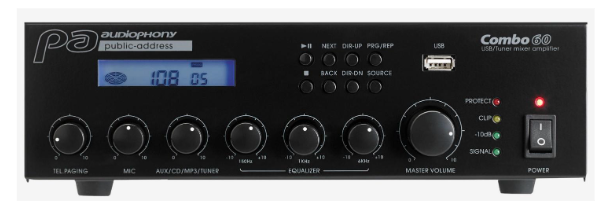
Also from Audiophony, we then point out a 4-channel power amplifier capable of delivering an impressive 4 x 240 W on a 100 V line: the AMP4240MKII. This amplifier features standard rack-format dimensions (2U in height), a weight of only 7.2 kg, but above all an essential design, with front ventilation grilles (internally there are fans), since it only performs the function of a power amplifier. The few adjustments present are on the back, such as the one to vary the sensitivity of the input channels and to insert a 180 Hz high-pass filter on them. The connectors are Euroblock for both inputs and outputs.

Finally, also very interesting-for various reasons, not least the price-is the 40 W Rondson PA-40 mixer/ampli. This small integrated first of all is extremely simple and intuitive to use, you do not need to be from the industry. The few controls on the front panel allow adjustment of microphone volume, echo, tones (bass/treble) and music volume, to which are added those for the media player. The USB drive can play MP3 or WMA files via USB stick or SD card. Also present is the recorder function from inputs 1 to 3 and the Bluetooth module for audio streaming from smartphones, tablets, PCs or any other enabled device.
On the back stands out an RCA aux input, low impedance (4 ohms) and 100 V speaker output with screw terminals (hi-fi style), and an input for DC power supply at 12 – 24 VDC .
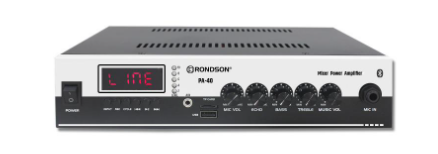
100 V speakers and loudspeakers, spoilt for choice
…and that is precisely why we have selected, for you, three different types.
Rondson, a French brand aimed specifically at the installation sector, has a series of 100 V in-wall loudspeakers in its catalog, of which the CSL 630 N is a part. This is a 2-way model with a 12-cm diameter woofer and 100-V line power of 20, 10 or 5 W. Placed at a height between 4 and 5 m above the ground, it can cover an area of 65 to 100 m2. It installs quickly and easily. Equipped with a flat, magnetic metal grid in black (a white model, CSL 630, is also available), it is an ideal solution for high-quality installations with an eye, however, on price.
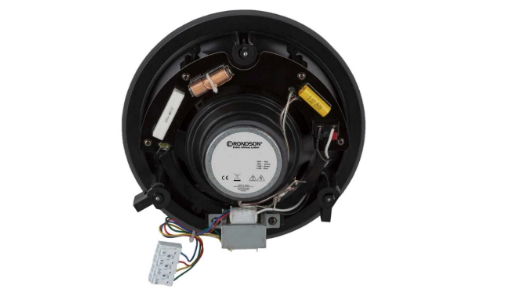
An alternative is the more economical CSL-506, a 130 mm wideband model for ceiling mounting, plastic chassis and metal grid, constant voltage operation from 70 and 100V with selection of 3 wattages: 3 / 6 / 12 W max.
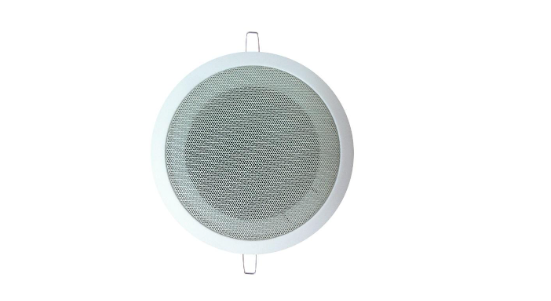
Also from the French manufacturer, we point out the PBT speaker line that includes four models: 10, 30, 50 and 80. True “problem solvers,” the Rondon PBT series are compact, with a modern trapezoidal section design (except for the PBT 10) to facilitate installation in corners and available in black and white. They operate at 70/100 V or low impedance on 8 ohms. If you have a venue such as a lounge bar or restaurant and want to sonify the rooms with a discreet and affordable solution for background music, seriously consider these products, which offer sound quality for music reproduction (they are two-way, two-speaker systems), small size and easy mounting thanks to the included wall bracket. They are also suitable for commercial premises, offices and museums due to their low visual impact. Wall installation also does not take away floor space.
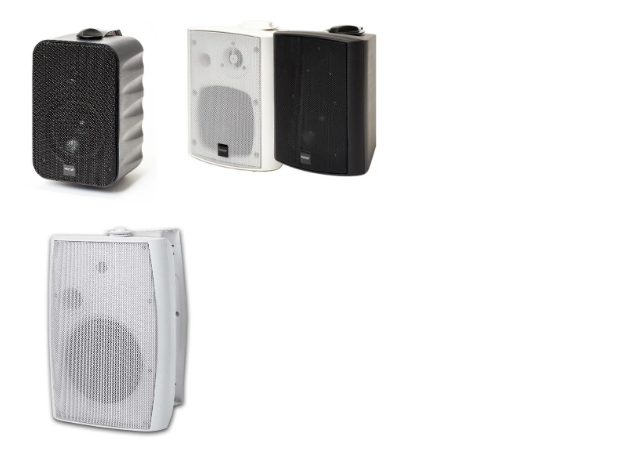
Those with even different needs will find in Rondson OD-506 FTN a valuable ally. This 16 W hanging spherical speaker, in black or white, is intended for small and medium commercial area sound broadcasting on 100 V line. An ABS body and metal grille encloses a 13-cm speaker that is capable of covering an area of 120 m2 from a height of 4 m. The power on line at 100 V is 4, 8 or 16 W, which means that it is possible to connect in parallel, for example, 25 speakers set to 4 ohms to a 100 W amplifier! Ideal for sound reinforcement in lobbies, supermarkets and stores.







